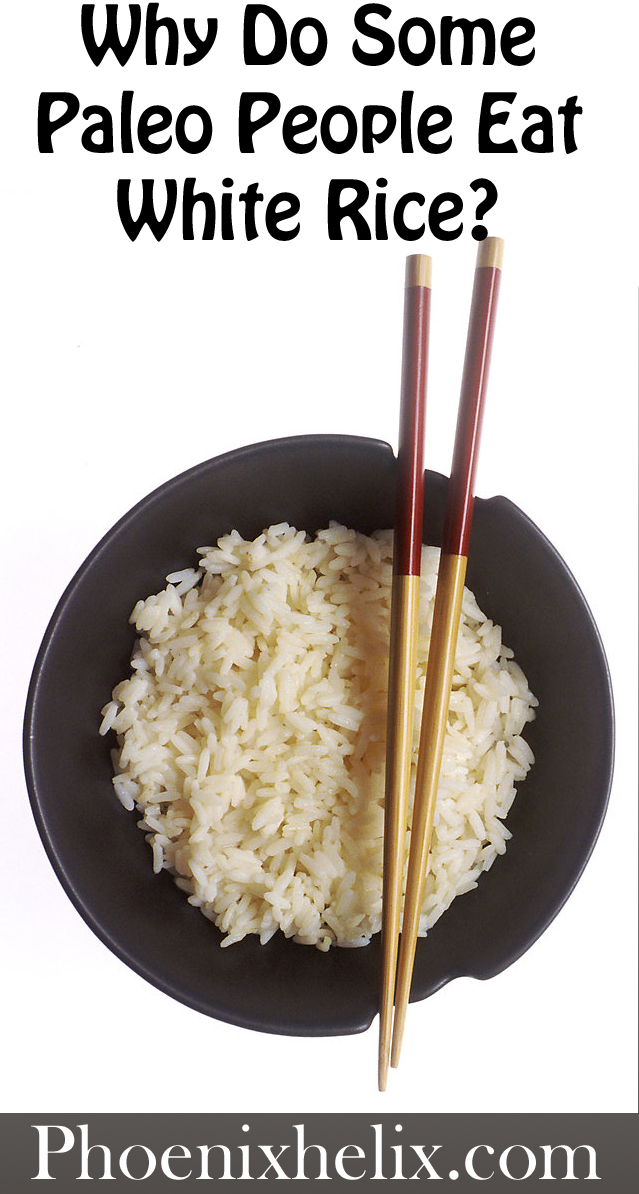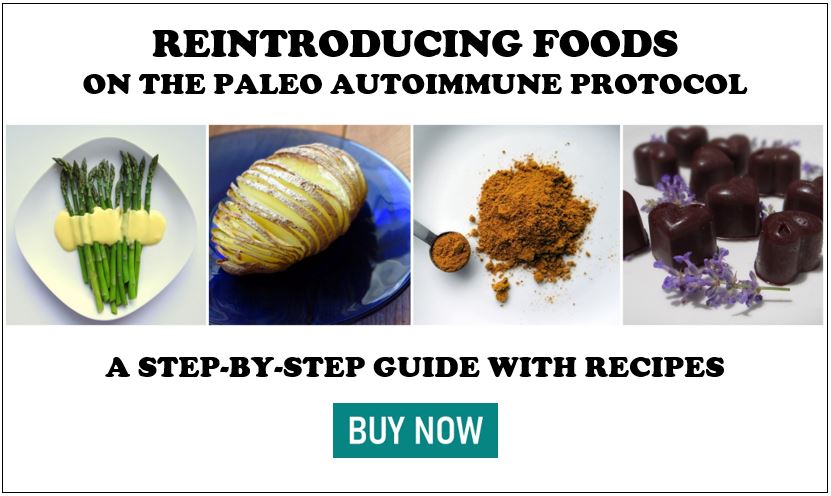“There’s more to good or bad than what’s written in the Rulebook.”
~ Jasper Fforde
Hey! I Thought Paleo Was 100% Grain-Free
It’s true that Strict Paleo is indeed grain-free, but if you’re in this community any length of time, you’ll see #teamwhiterice popping up on Instagram feeds. Some flexible paleo people (many of them famous bloggers) share food photos containing this one specific grain. No others. Just white rice. Why is that? In conventional nutrition, white rice is considered the worst choice because unless it’s enriched, it doesn’t have much going for it nutritionally. That’s because the hull has been removed from white rice, which contains the “nutrition”. It turns out that’s also the reason it’s embraced by some corners of the paleo community. The hull also contains the anti-nutrients – those food components that interfere with digestion and nutrient absorption, exacerbating our guts and causing an inflammatory response. Since those anti-nutrients have been removed, many people consider white rice to be a harmless grain. Therefore, people who want more variety in their diet might add it to their paleo template. Should you do the same? It depends. Below, I’ll share the potential positives and negatives of this “paleo grain”, so you can make your own choice.
Potential Positives of White Rice
- Prevents Glucose Deficiency – Paul Jaminet, author of The Perfect Health Diet, is a big reason why white rice is beloved by many in the paleo community. He includes white rice in his ancestral diet plan because it’s low in toxins, easy to digest, and provides the body with glucose. In fact, white potatoes and white rice digest into 100% glucose, whereas fruits and other starchy vegetables break down into a mixture of glucose and fructose. Glucose can be used immediately by the body, whereas fructose needs to be metabolized by the liver. Paul believes that low-carb diets can lead to glucose deficiencies resulting in health problems, and the addition of white rice can prevent this from happening.
- An Easy Carbohydrate Source – Russ Crandall is the most famous Perfect Health Diet blogger. His website is The Domestic Man, and he wrote the first PHD cookbook also: The Ancestral Table. Why is he such a fan of Paul’s work? Because when he first turned to paleo to reverse his autoimmune disease, he started losing too much weight, and he was skinny to begin with. He also struggled with extreme fatigue. Adding white rice back into his diet relieved the fatigue and helped him put on much-needed pounds. We all have different metabolisms, and some people need more carbs than others. When Stacy Toth, the blogger behind Paleo Parents, started weight training, she noticed she was getting fatigued and struggling with exercise recovery. Reintroducing white rice resolved those issues. She got her energy back.
- A Shelf-Stable Convenience Food – This is very rare on the paleo diet. When we switch to this style of eating, our pantries empty out, and we often invest in a second fridge or freezer to store all of our perishable foods. This is good – the most nutrient-dense food is fresh, not shelf-stable. That said, life is busy and to have one thing that’s convenient can feel like a gift.
- A Restaurant Option – Sushi is back on the table, and this makes many people very happy. However, gluten is everywhere in sushi restaurants, so you need to order carefully. Avoid all sauces and condiments, and bring your own coconut aminos instead. Ask the server if anything’s been added to the rice. And avoid the following items on the menu: crab meat and tempura. Here’s a good article on ordering sushi safely.
- Resistant Starch – Simply put, this is food for our microbiome instead of us (the bacteria that live in our gut). Beneficial bacteria are essential to our health, and resistant starch can increase their numbers. Caveat: if you have gut dysbiosis, pathogenic bacteria thrive on resistant starch as well. Provided you have more good than bad bacteria in your gut, resistant starch can help keep that balance. In fact, Grace Liu, a resistant starch expert who blogs at The Gut Institute prefers the type RS3 (which includes cooked and cooled white rice). She says, “The best, ancestral resistant starch for long-term health, leanness and modern, disruptive lifestyles is RS3, cooked-cooled resistant starch. The crystals that form upon cooling make up a dense, DNA-like configuration that our gut flora love.” The catch is that it’s a small amount, between 1-4 grams per 1/2 cup of cooked/cooled white rice. But maybe that’s not a bad thing. Many people with autoimmune disease have found that high doses of resistant starch create an inflammatory response. Perhaps this small amount is just what we need.
Potential Negatives of White Rice
- Blood Sugar Spikes – The same reason Paul Jaminet loves white rice can actually cause problems for some people. Its ability to digest into 100% glucose means it can have a dramatic impact on blood sugar. This is bad news not only for diabetics, but also people with autoimmune disease, because blood sugar affects autoimmune expression. Blood sugar spikes also lead to sugar cravings, setting off a vicious cycle. There are a few ways to moderate this effect, which I detail in the N=1 section below.
- Gluten Cross-Reactivity – If your body develops an allergy to gluten, it creates antibodies that remember gluten’s protein structure. If you eat gluten, those antibodies set off an inflammatory response. Some other foods have similar protein structures to gluten, and your body may mis-identify that food as gluten. Rice is one of these foods. Cross-reactivity doesn’t happen to everyone; in fact, it’s a small percentage of people. But it can happen, which is way Sarah Ballantyne recommends white rice as a late-stage reintroduction for those of us following the paleo autoimmune protocol.
- Arsenic – This toxin is naturally present in all soil, and is higher in some areas due to pesticides and fertilizer entering the water supply. Unfortunately, rice absorbs arsenic more readily than other plants. There is currently no FDA limit on arsenic in rice and rice products. Consumer Reports did thorough testing on various rice varieties from various locations. Here’s what they found: “White basmati rice from California, India, and Pakistan, and sushi rice from the U.S. on average has half of the inorganic-arsenic amount of most other types of rice….Those with a label indicating that it’s from Arkansas, Louisiana, or Texas or just from the U.S. (not California) had the highest levels of inorganic arsenic in our tests.” Compared to brown rice, white rice contains very small amounts, because most of the arsenic is absorbed into the hull. Even so, the trace amounts that remain can add up if you eat white rice daily. Consumer Reports recommends adults eat it no more than 4 times per week and children no more than twice a week. Note: organic rice contains just as much arsenic as inorganic. There is one more step we can take to minimize the arsenic. Traditionally in Asia, they rinse the rice and discard the water before cooking. This eliminates much of the arsenic in white rice.
- It Can Replace More Nutritious Choices – Nutrient-density is essential to healing our bodies, and with every bite we take, we make a choice about nutrition. Even if you add bone broth and healthy fats to white rice, it’s still not going to measure up to the nutrient-density of meat, seafood or vegetables. Even Paul Jaminet says it should only comprise a small part of the diet.
N=1 (Self-Experimentation)
So, now you know the pluses and minuses of this “paleo grain.” You may choose to continue to avoid it, or you may want to try adding it back into your diet. If you choose the latter, here’s my advice for the best way to do so:
- Choose the Right Time: If you’re following the paleo autoimmune protocol, wait until you are ready for reintroductions. White rice isn’t allowed during the elimination period. If you have gut dysbiosis or small intestine bacterial overgrowth, work with your healthcare practitioner on the best time to reintroduce.
- Choose a Low-Arsenic Variety: California basmati rice is the lowest, according to Consumer Reports. Rinse it well before cooking.
- Prepare it Nutritiously: For every 1 cup of white rice you cook, add 1 Tbsp. healthy fat along with 1/2 teaspoon sea salt and substitute bone broth for the water. If you have a pressure cooker like the Instant Pot, Paul Jaminet recommends it, saying it removes any trace anti-nutrients that might remain in the rice. You can find two nutritious white rice recipes in the Extras section of The Paleo AIP Instant Pot Cookbook.
- Maximize the Resistant Starch: Refrigerate it for at least 24 hours before eating. You can eat it either cold (like sushi) or reheat the rice gently. As long as it doesn’t reach boiling point, most of the resistant starch should remain. Also, adding fat during cooking (as recommended in step 3) also increases resistant starch.
- Minimize the Blood Sugar Impact: Cooking the rice in bone broth with healthy fat is already a step in this direction, as is increasing its resistant starch through refrigeration. If you eat the rice as part of a main meal, you’ll further lower its glycemic load. Lastly, if you have a little vinegar with your meal, that reduces the blood sugar effect even further. Interestingly, vinegar is traditionally added to sushi. “Su-shi” actually means “vinegared rice.” As usual, traditional cooking methods contain wisdom. Following your meal with a little apple cider vinegar in a small glass of water has the same effect, and is also a digestive aid. This said, some people will still have a blood sugar spike anyway. You can buy a glucose monitor and take a reading 2 hours after eating, to test your own blood sugar response. A healthy reading is below 120.
- Pay Attention: Each of us is unique in our response to food, and by listening to our bodies we can personalize our diet to include the foods that make us feel good and avoid the foods that make us feel bad. After reintroducing white rice, notice how you feel both immediately after eating, and for the next 72 hours. Any blood sugar changes you’ll notice pretty quickly. A food intolerance reaction can sometimes be delayed for up to three days. I polled my fellow autoimmune bloggers, and more people have reintroduced rice successfully than not. BUT some people did react negatively, so as always, follow your own body’s cues.
- Limit Consumption: If you reintroduce white rice successfully, enjoy it in moderation as part of your paleo template. Remember that you don’t want it to replace more nutritious food choices, nor do you want to risk getting too much arsenic by eating it every day. 4 times per week is the maximum recommended by Consumer Reports. And 10% of overall calories is the maximum recommended by Paul Jaminet. Among the autoimmune bloggers, most have it a maximum of once/week.
- Watch Out For Restaurants: Restaurants sometimes add wheat flour to rice to make it stickier. Strange, but true! Before ordering rice at a restaurant, ask them about this practice and confirm that the rice they serve is gluten-free.
You May Also Be Interested In
Credit: image at top of page from Free Stock Photos.











Thanks for this article. I reintroduced white rice a couple years ago “to be social” as Dr. Terry Wahls puts it in her book. (She is actually talking about grains in general). It just made it easier when inviting people for dinner or going out to a restaurant. It doesn’t seem to be a problem for me, though I cannot overindulge because of the glucose issues you mentioned. The slippery slope is the bigger issue for me. There is a pretty wholesome white rice flour-based bread that I just love. It’s too easy to have toast in the morning when a sweet potato and some sautéed greens would be the better choice. However, we are in this for the long haul so I appreciate a little more latitude thanks to white rice.
Thanks for sharing your experience, Therese. I agree – a sustainable healing diet has to balance nutrient-density with a little flexibility. Like you said, we are in this for the long haul! Wishing you wellness in every way.
So how does this correlate with rice as an ingredient in so many things? I assume if you successfully intro white rice then maybe you don’t have to worry so much about it as an ingredient either?
I would consider it a separate test, due to the different ways it might be prepared and how it combines with other ingredients. But yes, if you successfully reintroduce home-cooked white rice, it would be fine to also try reintroducing things like rice pasta and rice wraps and see how your body responds. While none of these would be considered health foods, it’s always nice to have some convenient options that expand your food freedom.
Good to know. I was thinking more like supplements with rice/ flour or bran in the ingredient list as well.
Thank you Eileen! Awesome article. I have been kicking around the idea of bringing a bit of rice in and this article put it all together for me…..The hyperlink to the CR article is great too. I so appreciate all you do. I actually happen to like cold rice….so, hey…It’s all good! 🙂 We shall see if my body will reject it or not….Hopeful. Take care….See you in FB land! 🙂 Mark in New Mexico.
Good luck, Mark!
Great article and good news about white rice. But give us a break, California Basmati? It’s a big world out here…..
Hi Mark. Did you read the whole article or just the highlights? I simply mentioned that Basmati from California had the lowest arsenic content, according to Consumer Reports. I didn’t tell people that was the only option. In fact, in the section on arsenic I provide more detail and more options.
Interesting read. I’ve been sensitive to rice since I was a baby, but I tried to give white rice a shot while pregnant and not able to eat much. Unfortunately, many of my rice symptoms returned. Now that I’m breastfeeding, sweet potatoes just aren’t cutting it. I might try some of these preparation tips and see if that makes a difference!
Let us know how it goes, Rheagan.
Hi Eileen,
Do you have a recommendation for how much should be consumed at the maximum? I’m planning to reintroduce white rice and I’m thinking of starting off with a quarter of a cup, but if I tolerate that and want to increase, what would be the largest serving size that’s recommended?
Thanks!
Paul
Hi Paul. Are you talking about starting with 1/4 cup cooked rice? I would recommend a maximum of 1 cup cooked. That’s what I do, and I always follow the steps in this article to maximum its nutrition and minimize its blood sugar impact. Best wishes with your reintro!
Thanks for this article! I have a friend who has psoriatic arthritis (as do I) and she went on a diet of white rice, fish, and veggies for a year straight. She has been symptom free for years now. She is a huge inspiration for me and reading her story helps lift me up when I am down. Considering what she has achieved with so much white rice in her diet, I have long wondered about white rice and its place in the AIP diet. Thanks for this article as it has added more clarity to my research. I’m assuming all that has been written also goes for white rice flour?
Hi Josh. I would start with a reintroducing regular white rice first, and if that goes well try the rice flour. Good luck!
Hi Josh, I also have PsA and would love to connect with your friend. I have tried so many different diets and nothing seems to be working.
Hi Eileen,
Great article (and your entire site)! A question- how does one know if they cross-react with rice?
Hi Ann. If you react negatively to rice, cross-reaction might be the reason (or not). If you want to know for sure you can take a test through Cyrex Labs (Array 4). Here’s an article I wrote for Autoimmune Paleo that explains cross-reaction in more detail: What is Gluten Cross-Reactivity?
Hello long lost friend! I so enjoyed reading this article tonight. True story, I am cooking some long grain white rice as we speak. Making a vegetarian dish tonight (cauliflower/middle eastern inspired spices). It’s easy to throw together and so good.
So I have to tell you, I am one of those who NEEDS carbs. I did *okay* on 100% Paleo, but did much better when I started eating rice again. I did read the article about the arsenic when that first started circulating. I was a little panicked at first because we eat sooo many rice products. But I try to eliminate the arsenic in rice here at home, as you suggested by soaking and rinsing until it runs almost clear. I am also experimenting with making my long grain rice more fluffy. I used less water tonight (3 cups of H2O to 2 cups of rice). It helped a lot.
I again enjoyed reading about white rice, as it’s a food I love and eat often. Wish I could grow it myself (wink wink). I started eating white rice because brown rice was impossible for me to digest. I would get bloated and gassy…I was a hot mess. I am happy to share that I’ve been in remission for 3 months! Woot. I’ve put on weight, have great energy…it’s so wonderful. Enjoying this good health.
Hugs,
–Amber
Remission! Yes! That’s awesome, Amber. Thanks for sharing your positive experience with white rice, and your happy news.
Thx for great points about rice!
Rice is an ancestral food for Asians. And it makes sense for us to eat rice, regardless the diet style, as it’s our staple food. We (Koreans) eat banchan – side dishes – that help cancel out anti-nutritional properties and prevent glucose spikes when eating rice so we don’t think about those issues at all. And even our preparation method is different than the West. So if you watch how we prepare and eat rice, like the few you mentioned in the post, you shouldn’t have any issues.
One anecdotal case study I want to mention about my daughter’s moderate case of Eczema that cleared up totally when she only had rice porridge because she couldn’t tolerate any food from food poisoning. That’s when we realized how food was affecting her Eczema but found out rice was totally ok. I think Paleo community should embrace rice and not fear it if their health tolerates it.
Thank you so much for sharing your experience, Karen. That’s a powerful testimonial. I will say that two of the autoimmune bloggers who weren’t able to reintroduce rice were of Asian descent. So, it’s not a given that everyone will tolerate rice, no matter their ethnic background. The best thing to do is to prepare it well, and pay attention during reintroduction to see whether or not it benefits your individual body.
Health is individualistic and so is how people react to food. Like I said in the last sentence, IF your health condition tolerates it (regardless of your ethnic background) you shouldn’t fear it…especially if people follow your recommendation of preparing and consuming it with certain foods.
Dr. Karen, I may have missed it if it has already been included-I apologize…but could you please post your recipe for the rice porridge?
Here is the recipe for rice porridge, Marcia. http://www.drkarenslee.com/vegetable-jook-rice-porridge-or-congee-recipe/
This is fabulous thanks for sharing that “non paleo” foods can have a place in our diets! I’ve been following paleo and then AIP and feeling exhausted, losing too much weight etc as i can’t tolerate most starchy veg due to gut imbalance + histamine issues. I added in white Jasmine rice and brain fog is lifting, weight going back on, energy coming back. Such a shift. I likely have SIBO, but Norm Robillard of Fast Tract Diet advocates Jasmine rice as the one rice that breaks down before it feeds the bad guys so it is safe for most people (again, listen to body). I’ve had no ill effects from it versus other white rices which really affect my gut.
That’s interesting about the Jasmine rice, Kristina. Thanks for sharing.
I’ve added white rice back to help with fatigue. I make coconut rice pudding so I’m also getting the resistant starch.
Yum!
Are you using digestive enzymes? I read in Julie Matthew’s book Nourishing Hope for Autism that specifically DPP-IV is helpful. I have been trying to reintroduce white rice & already use various Enzymedica products but will try their Glutenease.
Hi Lisa. I don’t use them myself. I find that natural digestive aids are enough for me. However, some people do find digestive enzymes helpful when they first start a healing diet, especially if their autoimmune disease has damaged their digestive tract. However, if you aren’t eating gluten, you shouldn’t need glutenease. If you are one of the few people who cross-react with rice, it’s better to avoid it than try to use a supplement to force your body to accept it.
Eileen, I love your focus on bio-individuality, and thank you for another helpful article. Our family is mostly grain free but we are able to have rice on an infrequent basis…too much and issues pop up, but enough to enjoy (with lots of healthy fat) occasionally 🙂
Hi Melanie. It’s all about finding the sweet spot. I’m so glad your family can enjoy it on occasion. And thank you so much for the compliments.
I’ve just finished interviewing 10 people who reversed their RA symptoms with diet, one of them found rice was a major trigger, worse than any other food, including gluten, yet others found it completely safe, all so individual! Also in this older elimination diet study rice affected 2 people in the group http://ard.bmj.com/content/47/1/69.full.pdf
That’s so fascinating. It’s a good reminder that although we start with the same paleo template, we are all unique, and testing out different foods lets us personalize our diet for us.
Great article! I think this was a really balanced look at the pros and cons of eating rice. I for one had a DRAMATIC improvement upon reintroducing rice. My hair was falling out in clumps and I was completely bedridden, so in desperation I staggered to the kitchen and made some thick congee with loads of chicken stock. I couldn’t believe the transformation within 24 hours. All the sweet potato in the world didn’t have the same effect!
Another of your articles explained why – due to my particular health conditions, I need the right amount of simple starches. It was life changing, and hammered home the importance of individualizing my diet. I’m still very ill and continue modifying my diet, but it’s another piece of the puzzle in place.
But as you point out, the downside is it can become easy to eat too much of it! Thanks for the reminder.
Keep up the good work Eileen, you’re my favourite AIP blogger 🙂
What a powerful experience. Thanks for sharing, Cindy!
I experienced the same thing. I’ve reintroduced 1/2 – cup to 1 cup white rice every other day and feel like a new person. I have made pancakes with a small mix of white rice four and do very well.
Same here, Cindy! I reintroduced rice into my diet about a month ago and have seem HUGE improvements in my health. I, too, started eating it out of desperation–I had been in AIP for 1.5 years and just kept getting worse. I was eating lots of sweet potatoes but just had this innate sense that my body just needed more starch/resistant starch. Thankfully it really helped me! I’ve seen a on of progress from adding it back in.
I really like your cooking suggestions, Eileen. I’m going to try cooking it with bone broth, adding coconut oil and cooling it for at least 24 hrs before eating. So thankful for this research you’ve done!
Thanks for sharing your story, Stacey. I’m so glad this post is resonating with people.
This is a great article! I’ve been wondering about the why/when/how. I have reintroduced white rice recently – it was an odd start, but overall I think I’m at least tolerating it in small, in-frequent doses. We shall see how it goes!
Thanks for sharing, Em. I hope it continues to go well!
Eileen – great article. Thank you.
Thanks for the praise. I learned a lot writing this article myself – one of the benefits of bloggin. 🙂
Very interesting. Thanks Eileen~. I’m thinking I might want to try a white rice n=1.
Good luck! Let us know how it goes.